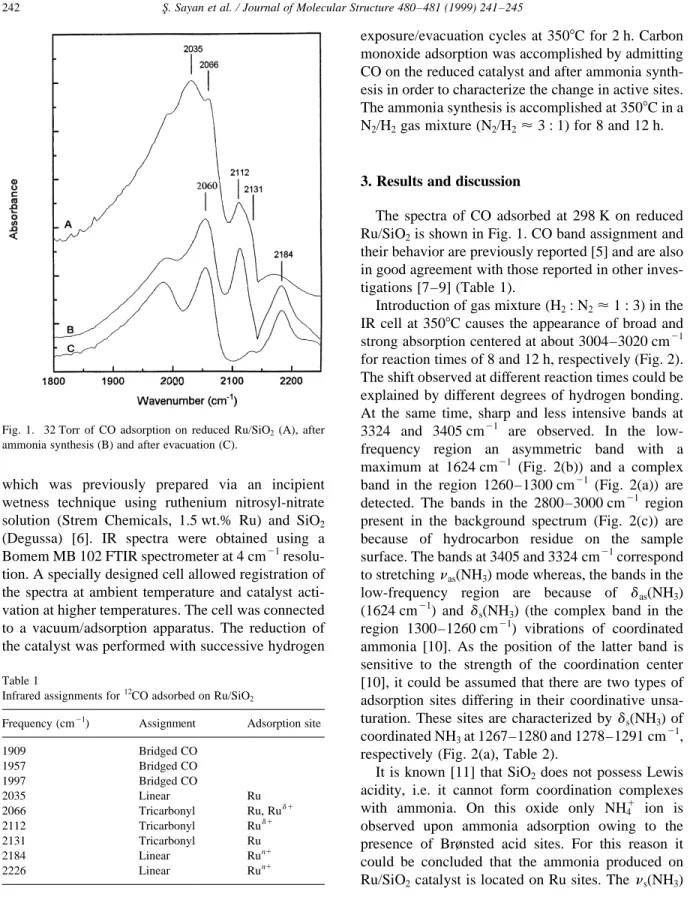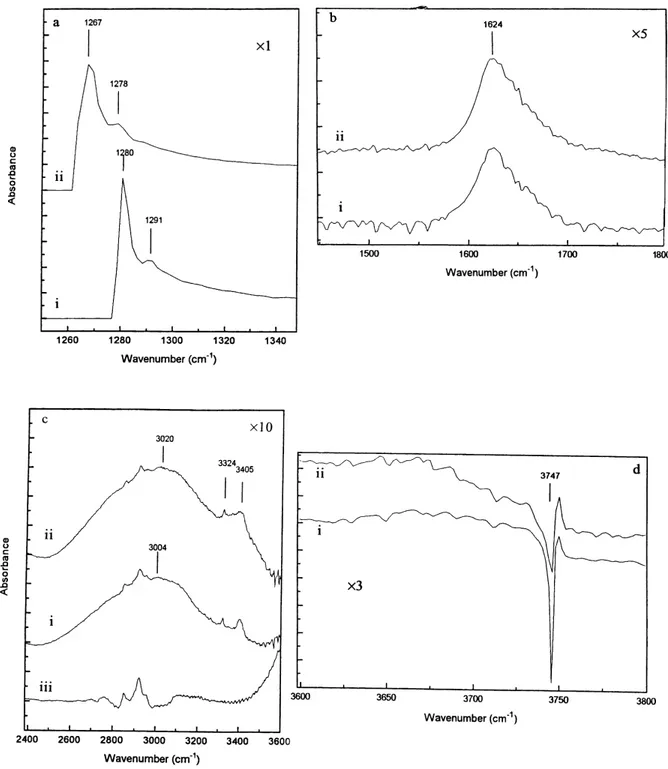FTIR characterization of Ru/SiO
2
catalyst for ammonia synthesis
S¸. Sayan
a, M. Kantcheva
a, S. Suzer
a,*, D.O. Uner
ba
Department of Chemistry, Bilkent University, 06533 Bilkent, Ankara, Turkey b
Department of Chemical Engineering, Middle East Technical University, Ankara, Turkey Received 24 August 1998; accepted 31 October 1998
Abstract
Carbon monoxide adsorption on a Ru/SiO2catalyst was followed by IR spectroscopy to investigate the active sites. Using this
catalyst, ammonia synthesis was achieved at 350⬚C in an N2/H2gas mixture (N2/H2⬇ 3 : 1) for different reaction times. In
addition to NH3other NHx(x 1,2) species were also observed. CO adsorption after NH3production was also performed to
investigate the change in nature of the active sites. Based on the experimental evidence participation of Ru0sites in ammonia synthesis was confirmed and a partial oxidation of the reduced Ru sites during the synthesis was observed.䉷 1999 Elsevier Science B.V. All rights reserved.
Keywords: Ru/SiO2catalyst; Ammonia synthesis; FTIR of adsorbed CO
1. Introduction
Ruthenium based catalysts are expected to be the second generation ammonia synthesis catalysts. The high activity of Ru-based catalysts at low tempera-tures coupled with their ease of reduction and good tolerance toward common reaction poisons make them potentially excellent catalysts for use in ammonia synthesis at thermodynamically favored low temperatures [1].
Aika et al. [2] prepared and characterized the chlorine-free ruthenium catalysts for ammonia syn-thesis. It was reported that Ru(NO)(NO3)3 and
Ru3(CO)12 were effective precursors among four
compounds, including Ru(acac)3and K2RuO4
(precur-sors) when they were supported on Al2O3. These
authors also found MgO to be the most efficient support among several pure oxides under low pressure
conditions. They reported that the activity was corre-lated roughly with the basicity of the support. The reason for studying chlorine-free ruthenium catalysts is that the chlorine originated from the precursor is left on the catalyst after activation and chlorine retards ammonia synthesis [3]. It was also reported [3] that Ru/Al2O3prepared from RuCl3gave a low dispersion
and that the value depends on the reduction tempera-ture. All the supports studied so far possess coordina-tively unsaturated cations. In order to avoid the influence of the Lewis acidity of the support and to isolate the role of ruthenium, we studied silica-supported ruthenium catalyst. Earlier, we used XPS and in-situ FTIR methods to characterize the Ru/SiO2
catalyst [4] and the mechanism of CO adsorption on it [5]. In this article we report FTIR spectroscopic inves-tigation of ammonia synthesis using this catalyst.
2. Experimental
A 4 wt.% Ru/SiO2catalyst was used in this study
0022-2860/99/$ - see front matter䉷 1999 Elsevier Science B.V. All rights reserved. PII: S 0 0 2 2 - 2 8 6 0 ( 9 8 ) 0 0 8 1 2 - 6
* Corresponding author. Tel.: ⫹ 312-266-4946; fax: ⫹ 90-312-266-4579.
which was previously prepared via an incipient wetness technique using ruthenium nitrosyl-nitrate solution (Strem Chemicals, 1.5 wt.% Ru) and SiO2
(Degussa) [6]. IR spectra were obtained using a Bomem MB 102 FTIR spectrometer at 4 cm⫺1 resolu-tion. A specially designed cell allowed registration of the spectra at ambient temperature and catalyst acti-vation at higher temperatures. The cell was connected to a vacuum/adsorption apparatus. The reduction of the catalyst was performed with successive hydrogen
exposure/evacuation cycles at 350⬚C for 2 h. Carbon monoxide adsorption was accomplished by admitting CO on the reduced catalyst and after ammonia synth-esis in order to characterize the change in active sites. The ammonia synthesis is accomplished at 350⬚C in a N2/H2gas mixture (N2/H2⬇ 3 : 1) for 8 and 12 h.
3. Results and discussion
The spectra of CO adsorbed at 298 K on reduced Ru/SiO2is shown in Fig. 1. CO band assignment and
their behavior are previously reported [5] and are also in good agreement with those reported in other inves-tigations [7–9] (Table 1).
Introduction of gas mixture (H2: N2⬇ 1 : 3) in the
IR cell at 350⬚C causes the appearance of broad and strong absorption centered at about 3004–3020 cm⫺1 for reaction times of 8 and 12 h, respectively (Fig. 2). The shift observed at different reaction times could be explained by different degrees of hydrogen bonding. At the same time, sharp and less intensive bands at 3324 and 3405 cm⫺1 are observed. In the low-frequency region an asymmetric band with a maximum at 1624 cm⫺1 (Fig. 2(b)) and a complex band in the region 1260–1300 cm⫺1 (Fig. 2(a)) are detected. The bands in the 2800–3000 cm⫺1 region present in the background spectrum (Fig. 2(c)) are because of hydrocarbon residue on the sample surface. The bands at 3405 and 3324 cm⫺1correspond to stretchingnas(NH3) mode whereas, the bands in the
low-frequency region are because of das(NH3)
(1624 cm⫺1) and ds(NH3) (the complex band in the
region 1300–1260 cm⫺1) vibrations of coordinated ammonia [10]. As the position of the latter band is sensitive to the strength of the coordination center [10], it could be assumed that there are two types of adsorption sites differing in their coordinative unsa-turation. These sites are characterized byds(NH3) of
coordinated NH3at 1267–1280 and 1278–1291 cm⫺1,
respectively (Fig. 2(a), Table 2).
It is known [11] that SiO2does not possess Lewis
acidity, i.e. it cannot form coordination complexes with ammonia. On this oxide only NH4⫹ ion is
observed upon ammonia adsorption owing to the presence of Brønsted acid sites. For this reason it could be concluded that the ammonia produced on Ru/SiO2catalyst is located on Ru sites. The ns(NH3)
Fig. 1. 32 Torr of CO adsorption on reduced Ru/SiO2(A), after
ammonia synthesis (B) and after evacuation (C).
Table 1
Infrared assignments for12CO adsorbed on Ru/SiO 2
Frequency (cm⫺1) Assignment Adsorption site
1909 Bridged CO 1957 Bridged CO 1997 Bridged CO 2035 Linear Ru 2066 Tricarbonyl Ru, Rud⫹ 2112 Tricarbonyl Rud⫹ 2131 Tricarbonyl Ru 2184 Linear Run⫹ 2226 Linear Run⫹
stretching modes and (ns⫹ 2das) combination band of
coordinated ammonia which are expected to be at about 3250 and 3150 cm⫺1 respectively, are over-lapped by the strong absorption at about 3000 cm⫺1. This strong and broad band could reveal the presence of amide groups (NH). Indeed, the associated secondary organic amides manifests their stretching vibration in the region 3100–3070 cm⫺1 [11,12]. These bands are intense and diffuse owing to hydrogen bonding. A decrease in the amount of isolated OH groups and appearance of OH hydrogen bonded groups may be because of interaction of NHx
species with surface single silanol groups (Fig. 2(d)). When compared with the CO adsorption spectrum of the reduced sample, it was seen that the band originally at 2066 cm⫺1 decreased significantly in intensity and shifted to 2060 cm⫺1. The band at 2035 cm⫺1 is not visible. The band at 2131 cm⫺1 and a component of the band at 2066 cm⫺1 were previously assigned to tricarbonyl species on metallic Ru centers whereas the band at 2035 cm⫺1 corre-sponded to monocarbonyl of the type Ru–CO in accordance with the literature data [5,7]. The absence of the band corresponding to Ru–CO species (2035 cm⫺1) and the decrease in intensity of the bands at 2057 and 2131 cm⫺1owing to Ru(CO)3on
the reduced catalyst is an evidence about the partici-pation of the Ru0sites in the ammonia synthesis. The band at 2112 cm⫺1 attributed to CO adsorbed on oxidized centers [5,7] is more intense suggesting an increase in the number of oxidized Ru sites. Here it should be noted that after evacuation of the reaction mixture at room temperature, no adsorbed NHx(x
1–3) was observed, i.e. that the active sites are liber-ated from the reaction product and intermediates and they were available for CO adsorption.
The origin of the bands at 2184 and 2226 cm⫺1
observed upon CO adsorption on the catalyst used in ammonia synthesis (the reaction mixture was evacu-ated prior to CO adsorption) is not clear. However, it is possible to assign them to Run⫹–CO where n⬎ 2. They show stability upon evacuation suggesting the presence of strong Lewis acid sites. Based on the experimental observations it is concluded that during the ammonia synthesis partial oxidation of the reduced Ru sites takes place.
4. Conclusion
The Ru/SiO2catalyst studied is active for ammonia
synthesis on which further kinetic studies should be accomplished for determination of its efficiency. The NHx(x 1–2) species represent intermediates in the
ammonia synthesis reaction. The adsorption of CO on the catalyst surface after ammonia synthesis reveals that partial oxidation of the reduced Ru sites occurs which indicates that the active phase for ammonia production is metallic ruthenium.
References
[1] H. Topsøe, M. Boudart, J.K. Nørskov, Frontiers in Catalysis: Ammonia Synthesis and Beyond, Basel, 1994.
[2] K. Aika, T. Takano, S. Murata, J. Catal. 136 (1992) 126. [3] S. Murata, K. Aika, Appl. Catal. 82 (1992) 1.
[4] S. Sayan, S. Suzer, D.O. Uner, J. Mol. Struct. 410-411 (1997) 111.
[5] M. Kantcheva, S. Sayan, Catal. Lett., submitted.
[6] D.O. Uner, M. Pruski, B.C. Gerstein, T.S. King, J. Catal. 146 (1994) 146.
[7] G.H. Yokomizo, C. Louis, A.T. Bell, J. Catal. 120 (1989) 1. [8] T. Mizushima, K. Tohji, Y. Udagawa, A. Ueno, J. Am. Chem.
Soc. 112 (1990) 7887.
[9] R.A. Dalla Betta, J. Phys. Chem. 79 (1975) 2519. Table 2
Assignment of IR bands observed after NH3synthesis
Absorption bands (cm⫺1) Compound Interpretation
1260–1300 NH3 ds(NH3) 1624 NH3 das(NH3) 2800–3000 Hydrocarbon residue 3004, 3020 NHx(x 1–3) nas(NHx),ns(NHx) 3324 NH3 nas(NH3) 3405 NH3 nas(NH3)
[10] A. Davydov, IR Spectroscopy Applied to Surface Chemistry of Oxides, Nauka, Novosibirsk, 1984.
[11] S. Holly, P. Sohar, Absorption Spectra in the Infrared Region, Akademiai Kiado, Budapest, 1975.
[12] K. Nakanishi, P.H. Solomon, Infrared Absorption Spectro-scopy, Holden-Day, San Francisco, 1977.

